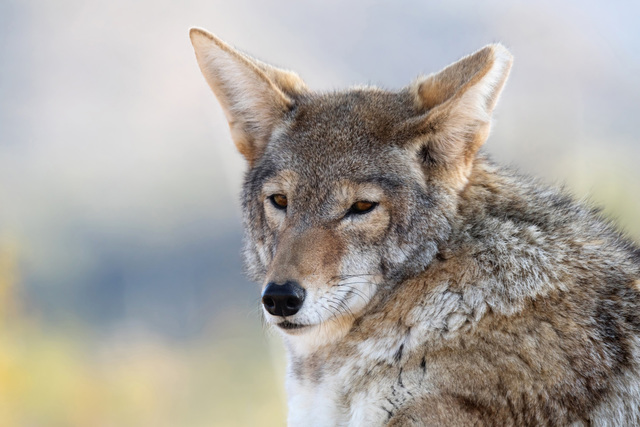Experts advise Sun City Summerlin residents how best to deal with coyote population
Coyotes slinking around golf courses and backyards — it seemed everyone in Sun City Summerlin had a story about recent encounters with the desert-dwelling creatures.
The Sun City Summerlin Community Association Board of Directors brought in experts to address the issue Sept. 14 during a meeting at the Desert Vista Community Center.
Roslyn Barron said a coyote jumped her 4-foot-tall fence about 5 a.m. this summer and attacked her dog Scribble, a Yorkshire terrier.
“I let him out, and from the front door to the bedroom is, what, five seconds?” she said. “And I come out, and he’s laying (sic) there, blood all over, and the coyote is right there.”
She chased the coyote off and raced her dog to the vet, but Scribble had to be euthanized.
In February, Carla Fishman ran outside to save her rescue dog Copper, a mixed breed of about 19 pounds, when two coyotes attacked him.
“One had his neck in its mouth, and the other one was chomping on him,” she said. “He’s a fierce dog. He’s attacked other dogs, but he was fighting for his life.”
She grabbed a big flashlight and scared the coyotes off. Copper survived. She said it was her fourth incident with coyotes over the past year.
Cindy Tashiro and her husband, Thomas, have two small dogs, Coco and Cici. Coco was attacked in November in their backyard.
“We didn’t have a clue that she was attacked,” said Cindy Tashiro, “until … we saw the blood.”
The day’s topic drew so many people, the meeting moved from the intended combined meeting rooms into the auditorium. There, experts addressed the problem and spoke of actions one could take. On hand were Josh Cerda, urban wildlife coordinator with the Nevada Department of Wildlife; Cindy Leavitt, animal control supervisor with the city of Las Vegas, and Karen Layne, president of the Las Vegas Valley Humane Society.
Ken Caroccia, Sun City board member, began the meeting by saying, “We’re seeing more and more coyotes, and they’re getting more and more brazen.”
Cerda advised attendees that living in the Mojave Desert came with wildlife, and those animals were looking for food. While he couldn’t provide numbers, he said the area had a “very healthy” coyote population. He said golf courses and parks create an unnatural environment in urban areas that attract squirrels, mice, rabbits and rats — all the things that coyotes eat.
“And it’s the desert, so water is a high commodity,” Cerda said. “Animals will travel a very long distance to (drink).”
He said killing coyotes was not the answer.
“Nature always maintains a balance,” he said. “… So, if we were to take out the coyotes, you guys would be here next year talking about all the mice and rabbits.”
Layne agreed, saying coyote killing did nothing but prompt nature to increase the population. They reproduce and quickly.
“We had one body of a female that had 19 fetuses in it,” she said.
Cerda said hazing — screaming, shouting, raising the hands up high to appear bigger or “anything to make them uncomfortable” — was effective.
Layne demonstrated various types of leashes, telling attendees that dogs outside need to be under your control should a coyote appear. She held up a soda can, empty except for a few pennies. When she rattled it, it made a loud noise. It was enough of a startle mechanism, she said, to send coyotes running.
Dusk is when coyotes are more likely to appear. If your dog is being walked at that time, it could cause an issue, they said.
“A lot of people will feed their dogs and cats outside. (The food) attracts — guess what? — coyotes,” Layne said. “If you’re going to do it, pick it up as soon as they’re done.”
She said putting out trash in plastic bags also attracts coyotes. Better to use a closed-top bin. Republic Services is in the process of distributing larger containers.
Even not picking up dropped fruit from trees could lure coyotes.
According to projectcoyote.org, Western coyotes typically weigh 18 to 30 pounds and look similar to a small German shepherd or collie-type dog. In rural habitats, coyotes hunt by day and night. In urban areas, they appear to be more nocturnal but can often be seen during daylight hours, especially at dawn and dusk.
Coyotes can run up to 40 mph and jump 6 feet high. They are omnivores and scavengers and will eat a variety of foods, taking advantage of whatever they can find.
On the plus side, they “provide an ecological service by helping to keep our communities clean of carrion,” the site says.
The Crabtree and Sheldon study of 1999 found that populations are naturally regulated by available food and habitat. Killing them disrupts the group hierarchy and allows more coyotes to reproduce, often with larger litter sizes because of decreased competition for food and habitat.
Leavitt said her department would take a report if a house pet was injured or killed by a coyote but would not pursue a strategy of eradicating them.
“Something I learned not too long ago … make sure your grounds are being kept,” she said. “If you have brush, they can (hide). If you go through some of the parks, you’re going to see where wildlife has laid.”
Audience member Gene Wilson citedgraphic details about a 3-year-old who he said was killed by a coyote in California in 1981.
“If you think these are cute, cuddly animals, you’re deadly wrong,” he said.
“There has never been a single attack on a human (by coyotes) in Nevada,” Cerda said. “How many attacks each year are reported by domestic dogs? … About a thousand.”
He said the two incidents where a person was bit by a coyote was when they tried to break up a fight between the wild animal and their dog. It was undetermined if the bite was from the dog or the coyote.
“You don’t get in the middle of a dog fight without expecting to get bit,” he said.
Sun City resident Paul Madigan said he dealt with coyotes for 20 years when he lived in Colorado. He’s had three confrontations in the last two weeks in his backyard.
“You make a lot of noise, you (carry) a golf club,” he said. ” … Treat your pet like your grandkids and your kids, you won’t have a problem.”
“They have a natural instinct to fear people,” Cerda added. “As they see more people, and no one does anything to threaten them, they become more comfortable. So, haze them, throw things at them and approach them. They will not let you get within a few feet.
“As long as you make that territorial animal retreat, it goes a long way in their brain that there is more risk than reward by coming into the area.”
To reach Summerlin Area View reporter Jan Hogan, email jhogan@viewnews.com or call 702-387-2949.
















